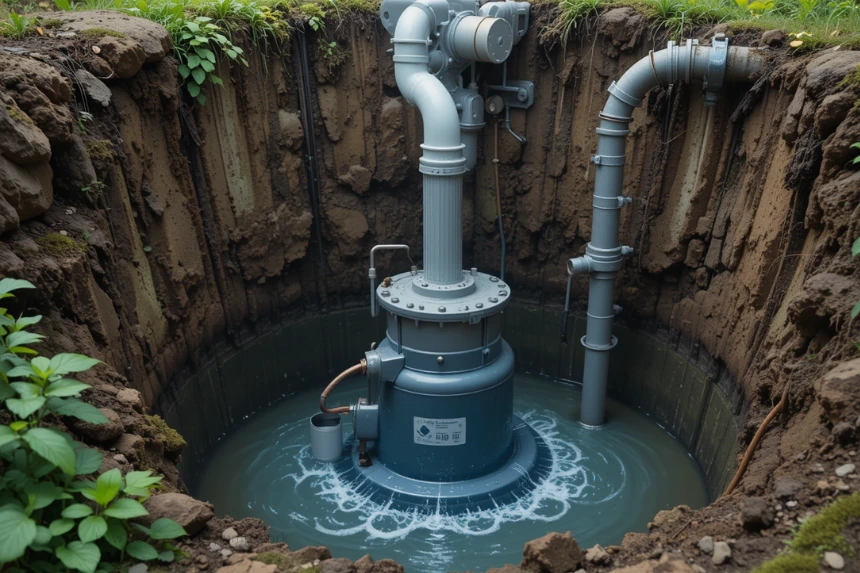When it comes to safeguarding your home from water damage, a sump pump is an indispensable device, especially in areas prone to flooding or heavy rainfall. But many homeowners wonder, “How does a sump pump work?” Knowing its mechanics will enable you to recognize its significance and make wise maintenance and installation decisions.This article provides a comprehensive look at how a sump pump functions, its key components, and why it’s crucial for basement waterproofing.
What Is a Sump Pump?
A sump pump is a mechanical device used to remove accumulated water from a crawlspace or basement in a house. It is typically placed in a sump basin or pit, which is a specially dug hole designed to collect water seepage from the soil or groundwater. The primary purpose of a sump pump is to prevent flooding and water damage by automatically pumping out excess water before it can cause harm to your property.
The Basic Components of a Sump Pump System
To understand how a sump pump works, it’s essential to familiarize yourself with its main parts:
Sump Basin/Pit: The container where water collects.
Pump Motor: The motor powers the pump to move water out.
Discharge Pipe: The pipe that channels water from the pump to a safe drainage area.
Float Switch: A device that detects water level changes and activates the pump.
Check Valve: Prevents backflow of water into the sump pit after being pumped out.
Each component works together seamlessly to ensure effective operation, whether during heavy rain or groundwater seepage.
How Does a Sump Pump Detect Water?
A key part of how a sump pump works is its ability to detect water levels. The float switch, which looks like a buoyant ball or a vertical float mechanism, is mainly responsible for this detection. As water accumulates in the sump basin, it causes the float to rise. Once the water reaches a predetermined level, the float switch triggers the pump to turn on. Conversely, when the water level drops after pumping out, the float switch signals the pump to turn off.
The Pumping Process: Step-by-Step
Understanding the pumping process clarifies how a sump pump maintains dry and safe basements. Here is a step-by-step overview:
Water Collection: Water seeps into the sump basin through cracks, porous soil, or drainage systems. As the water level rises, the float switch begins to react.
Activation: When the water reaches a certain height, the float switch activates the motor of the sump pump.
Pump Operation: The motor powers the impeller or rotor inside the pump, creating centrifugal force that pushes water through the discharge pipe.
Water Discharge: The pumped water exits the sump basin via the discharge pipe and is directed away from the house, ideally to a storm drain or a dry area far from the foundation.
Deactivation: The pumping process is stopped when the water level drops below the trigger point of the float switch, which instructs the pump to shut off.
This cycle repeats automatically whenever water accumulates, providing continuous protection without manual intervention.
Types of Sump Pumps and How They Function
There are different types of sump pumps tailored to various needs:
Submersible Sump Pumps: Fully submerged in the sump basin, these pumps are quiet and efficient. They are ideal for larger basins or high water inflow situations.
Pedestal Sump Pumps: Positioned outside or on the edge of the sump basin with the motor above the water level. They are easy to maintain but tend to be noisier.
Battery-Backup Sump Pumps: Designed to operate during power outages, these pumps provide additional security, especially during severe storms that can knock out power.
Although their mechanisms differ slightly, all types function on the principle of water detection and automatic pumping.
Why Is Proper Maintenance Essential?
Knowing how a sump pump works highlights the importance of regular maintenance to ensure its reliability. Common maintenance practices include:
To check if the pump functions, periodically test it by adding water to the sump pit.
Cleaning the sump basin and removing debris or sludge that could hinder performance.
Inspecting the float switch for proper movement.
Checking the discharge line for blockages or leaks.
Ensuring the backup power source is functional, especially for battery-powered models.
Regular upkeep prolongs the lifespan of your sump pump and guarantees optimal protection for your home.
Common Troubleshooting Tips
Sometimes, sump pumps may fail or operate inefficiently. Here are some troubleshooting tips:
- If the pump doesn’t turn on, check the float switch and power supply.
- An excessive amount of noise may be a sign of motor problems or debris in the pump.
- Persistent flooding despite the pump working suggests a problem with the discharge line or insufficient capacity.
- An unresponsive pump may need professional repair or replacement.
Addressing these issues promptly can prevent costly water damage.
Conclusion: The Critical Role of Sump Pumps
Understanding how a sump pump works reveals its vital role in maintaining a dry, safe home environment. By automatically detecting water levels, activating the motor, and pumping out excess water, sump pumps serve as the frontline defense against basement flooding. Regular maintenance and proper understanding of their operation can ensure your sump pump performs effectively when you need it most, providing peace of mind during storms or rainy seasons.



